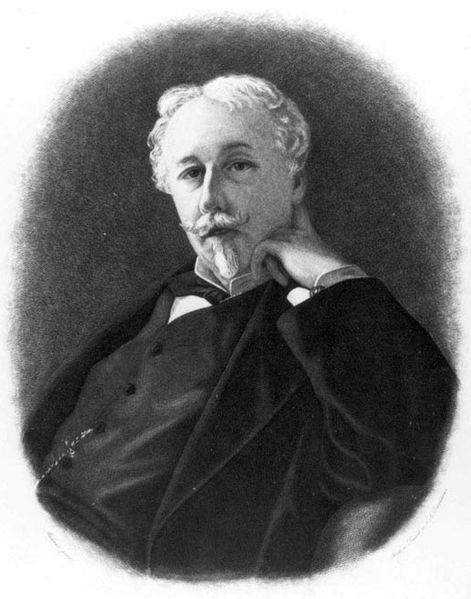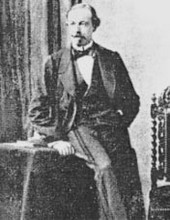<Back to Index>
- Philosopher Joseph Arthur Comte de Gobineau, 1816
- Folk Songwriter Woodrow Wilson "Woody" Guthrie, 1912
- Anarchist Revolutionary José Buenaventura Durruti Dumange, 1896
PAGE SPONSOR


Joseph Arthur Comte de Gobineau (14 July 1816, Ville - d'Avray, Hauts - de - Seine – 13 October 1882, Turin) was a French aristocrat, novelist and man of letters who became famous for developing the racialist theory of the Aryan master race in his book An Essay on the Inequality of the Human Races (1853 – 1855). De Gobineau is credited as being the father of modern racial demography.
Gobineau's father was a government official and staunch royalist, and his mother, Anne - Louise Magdeleine de Gercy, was the daughter of a royal tax official. He was not, however, a nobleman, having added the 'count' to his name himself.
In the later years of the July Monarchy, Gobineau made his living writing serialized fiction (romans - feuilletons) and contributing to reactionary periodicals. He struck up a friendship and had voluminous correspondence with Alexis de Tocqueville, who brought him into the foreign ministry while he was foreign minister during the Second Republic.
Gobineau was a successful diplomat for the Second French Empire. Initially he was posted to Persia, before working in Brazil and other countries. He came to believe that race created culture, arguing that distinctions between the three races - "black", "white", and "yellow" - were natural barriers, and that "race - mixing" breaks those barriers and leads to chaos. He classified Southern Europe, Eastern Europe, the Middle East, Central Asia, and North Africa as racially mixed.
Gobineau also questioned the belief that the black and yellow races belong to the same human family as the white race and share a common ancestor. Trained neither as a theologian nor a naturalist and writing antecedent to the popular dissemination of a theory of evolution, Gobineau took the Bible to be an accurate account of human history and accepted in An Essay on the Inequality of the Human Races the day's prevailing Christian doctrine that all human beings shared the common ancestors Adam and Eve (monogenism as opposed to polygenism). Nonetheless, he suggested that except for the Church's teaching there were no other indicators to suggest the colored races descended, like the white race, from Adam, since ".. nothing proves that at the first redaction of the Adamite genealogies the colored races were considered as forming part of the species".
Gobineau believed the white race was superior to the other races in the creation of civilized culture and maintaining ordered government. However, he also thought that the development of civilization in other periods was different than in his own and speculated that other races might have superior qualities in those civilization periods than in his own. Nonetheless, he believed European civilization represented the best of what remained of ancient civilizations and held the most superior attributes capable for continued survival. His primary thesis in regards to this theory was that European civilizational flowering from Greece to Rome and Germanic to contemporary sprang from, and corresponded to, the ancient Indo - European culture, also known as "Aryan". Gobineau originally wrote that, given the past trajectory of civilization in Europe, white race miscegenation was inevitable and would result in growing chaos. He attributed much of the economic turmoil in France to pollution of races. Later on in his life, with the spread of British and American civilization and the growth of Germany, he altered his opinion to believe that the white race could be saved.
Paradoxically, although Gobineau saw hope in the expansion of European power, he did not support the creation of commercial empires with their attendant multicultural milieu, concluding that the development of empires was ultimately destructive to the "superior races" that created them, since they led to the mixing of distinct races. Instead, he saw the later period of the 19th century imperialism as a degenerative process in European civilization. To support his conclusion, he continually referred to past empires in Europe and their attendant movement of non-white peoples into European homelands in explaining the ethnography of the nations of Europe.
According
to his theories, the mixed populations of Spain, most of France and
Italy, most of Southern Germany, most of Switzerland and Austria, and
parts of Britain, derived from the historical development of Roman,
Greek, and Ottoman Empires which had opened up Europe to non-Aryan
peoples of Africa and the Mediterraneum cultures. Also according to
him, southern and western Iran, Southern Spain and Italy, consisted of
a degenerative race arising from miscegenation. Also according to him, the whole of north India consisted of a yellow race. Hitler and Nazism borrowed much of Gobineau's ideology, though Gobineau himself was not anti-Semitic, and may even be characterised as philo-Semitic. Gobineau wrote positively about the Jews, including the long eulogy to the Jews in his Essai sur l'inégalité des races, describing them as "a strong, a free, an intelligent people". When the Nazis adopted Gobineau's theories, they were forced to edit his work extensively to make it conform to their views, much as they did in the case of Nietzsche. Gobineau visited Bayreuth, home of Richard Wagner shortly before his death. Though in no way espousing his beliefs, Bahá'ís know Gobineau as the person who obtained the only complete manuscript of the early history of the Bábí religious movement of Persia, written by Hajji Mirzâ Jân of Kashan, who was put to death by the Persian authorities in c.1852. The manuscript now is in the Bibliothèque Nationale at Paris. Gobineau wrote novels in addition to his works on race, notably Les Pléiades (1874). His study La Renaissance (1877) also was admired in his day. Both of these works strongly expressed his reactionary aristocratic politics, and his hatred of democratic mass culture.